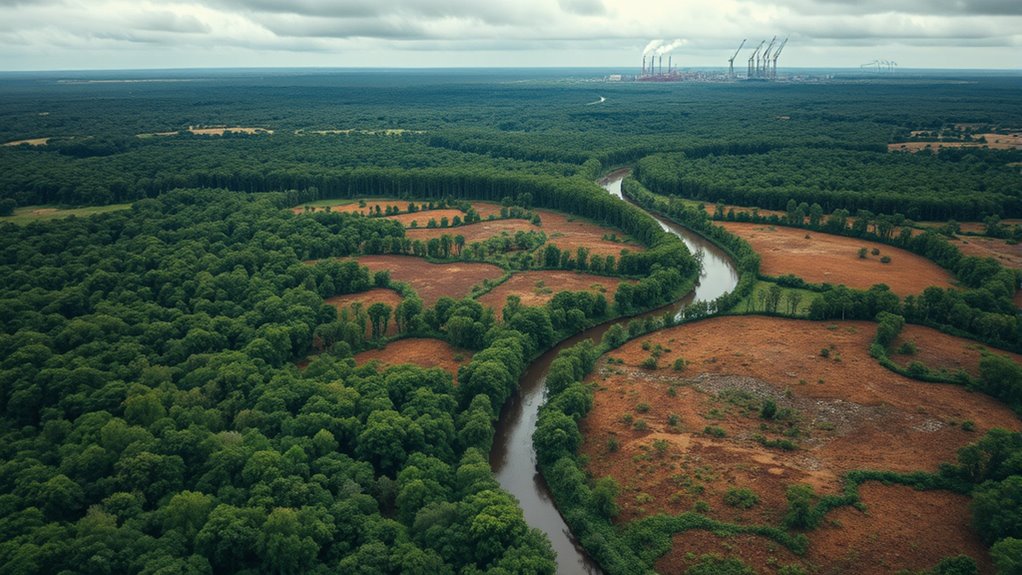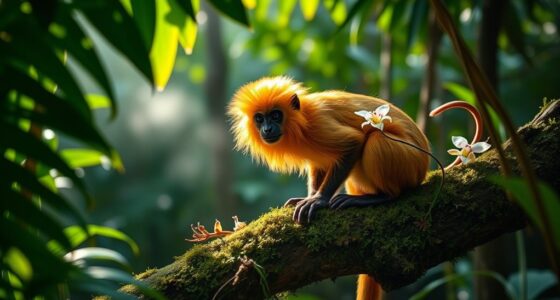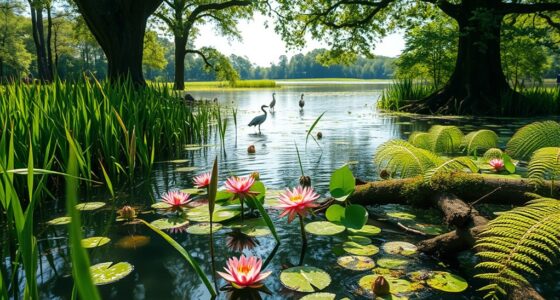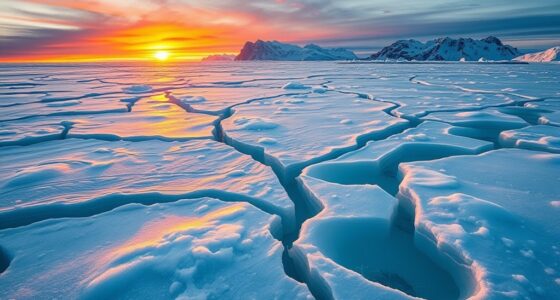Biodiversity loss is driven mainly by habitat destruction, invasive species, pollution, and climate change, which threaten native plants and pollinators like bees and butterflies. To address this, early detection of invasive species, habitat restoration, and planting native plants are essential. Raising awareness and community participation also play critical roles in conservation. If you want to understand how these solutions can help preserve ecosystems and guarantee future sustainability, continue exploring this important topic.
Key Takeaways
- Major drivers of biodiversity loss include invasive species, habitat destruction, pollution, climate change, and overexploitation.
- Invasive species outcompete native plants and animals, disrupting ecosystems and reducing native biodiversity.
- Conservation solutions involve early detection and removal of invasive species, habitat restoration, and planting native species.
- Raising public awareness and community participation are crucial for effective biodiversity conservation efforts.
- Protecting and restoring natural habitats supports pollinator populations and maintains ecological balance.
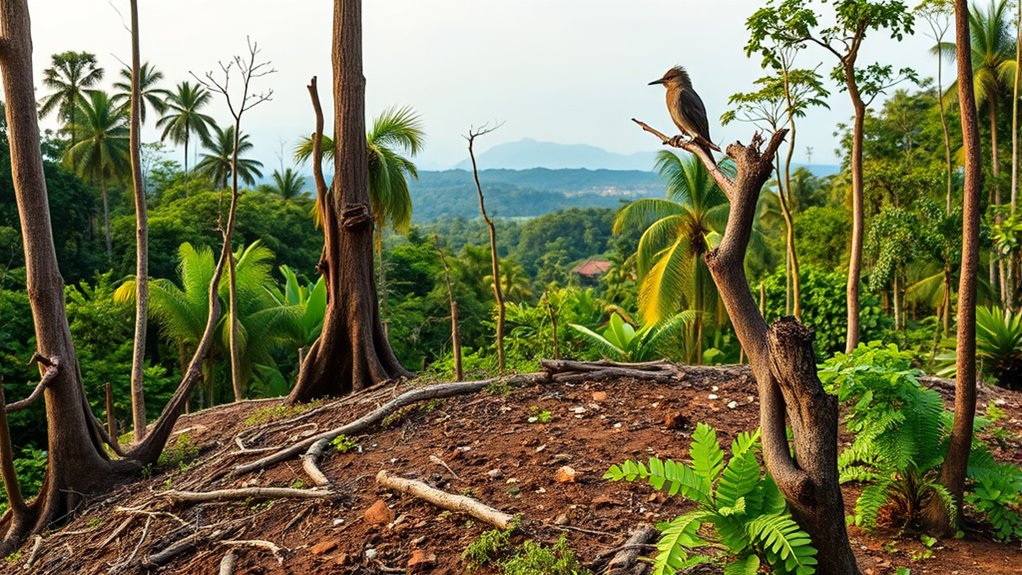
Have you ever wondered what happens when the variety of life on Earth starts to disappear? One critical consequence is pollination decline, which directly threatens the plants you rely on for food, medicine, and ecosystems. When biodiversity drops, the number of pollinators like bees, butterflies, and birds also diminishes. These creatures are essential for transferring pollen from one flower to another, enabling plants to reproduce. Without enough pollinators, many plants struggle to produce fruits and seeds, disrupting food supplies and natural habitats. This decline isn’t just a minor inconvenience; it can trigger a cascade of ecological failures that affect entire communities, including humans.
Compounding the problem of pollination decline is the increasing presence of invasive species. These non-native plants, animals, or microbes are introduced—sometimes accidentally, sometimes intentionally—and often outcompete native species for resources. Invasive species can alter habitats in ways that make it harder for native pollinators to thrive. For example, an invasive plant might dominate a landscape, monopolizing nectar sources and pushing out native flowering plants. This reduces the diversity of available food for pollinators, making it even more difficult for them to survive and perform their essential role. As native plants decline, the insects and birds that depend on them also suffer, further weakening the intricate web of life.
You might not immediately see the connection, but invasive species often create a domino effect. They can change soil chemistry, water availability, and the structure of habitats, making environments inhospitable for native species. This shift can lead to a reduction in biodiversity, as native plants and animals struggle to compete with the newcomers. The loss of native pollinator species, in turn, hampers the reproduction of native plants, which are often specially adapted to local conditions. This cycle accelerates biodiversity loss and destabilizes ecosystems that you depend on for clean air, water, and resources. Understanding the importance of biodiversity is crucial for recognizing how interconnected these issues are and the need for targeted conservation efforts.
Addressing these issues requires targeted efforts. Controlling invasive species through early detection and removal can help protect native habitats. Promoting habitat restoration and planting native species can also bolster populations of native pollinators. Additionally, raising awareness about the importance of biodiversity and the threats posed by invasive species encourages community participation in conservation initiatives. By taking these steps, you can help mitigate pollination decline and preserve the complex interactions that sustain life on Earth. The health of ecosystems depends on maintaining biodiversity, and your actions can make a meaningful difference in reversing these troubling trends.
Frequently Asked Questions
How Does Climate Change Specifically Affect Biodiversity?
Climate change directly impacts biodiversity by causing warming temperatures and altered weather patterns. You’ll see climate feedbacks, like melting ice and increased greenhouse gases, accelerate these changes. Species migration shifts as animals move to find suitable habitats, often leading to disrupted ecosystems. These changes threaten plant and animal survival, reduce biodiversity, and can cause long-term ecological imbalances that affect your environment and the services it provides.
What Role Do Invasive Species Play in Biodiversity Loss?
Invasive species disrupt ecological balance by outcompeting native species for resources, often leading to declines or extinctions. You might not realize it, but when invasive species establish themselves, they alter habitats, reduce biodiversity, and threaten the survival of native plants and animals. Their rapid spread and adaptability make them a significant driver of biodiversity loss, emphasizing the need for control measures to protect native ecosystems and maintain ecological balance.
Can Urban Development Be Sustainable Without Harming Biodiversity?
Think of urban development as a delicate dance—when done right, it can move gracefully without stepping on nature’s toes. You can achieve sustainability by integrating thoughtful urban planning and green infrastructure, creating spaces that support biodiversity. By designing cities that coexist with ecosystems, you protect habitats and foster thriving wildlife. With careful planning, urban growth doesn’t have to harm biodiversity; instead, it can become a harmonious part of the environment.
How Do Conservation Efforts Differ Across Continents?
You’ll find that conservation efforts differ across continents due to cultural, economic, and political factors. In Africa, indigenous knowledge plays a crucial role in managing protected areas, fostering community involvement. In Asia, government-led initiatives focus on protected area management to preserve biodiversity. Meanwhile, in South America, local communities often lead conservation efforts, blending traditional practices with modern strategies. These diverse approaches reflect each continent’s unique social and ecological context.
What Are the Economic Impacts of Biodiversity Decline?
You might not realize it, but biodiversity decline quietly affects your economy through reduced ecosystem services and lower economic valuation. When species diminish, it hampers natural resources like clean water, fertile soil, and pollination, which are essential for agriculture, tourism, and fisheries. This decline can lead to increased costs and decreased productivity, ultimately impacting your financial well-being and community resilience. Protecting biodiversity guarantees these indispensable services continue supporting your economy.
Conclusion
Think of Earth’s biodiversity like a delicate tapestry; each thread matters. When one thread frays or breaks, the entire fabric weakens. By understanding the drivers behind biodiversity loss and actively working on solutions, you can help mend this fragile tapestry. Your choices, from supporting conservation to reducing pollution, are like stitches that strengthen our planet’s intricate fabric. Together, you have the power to preserve the vibrant mosaic of life for generations to come.
